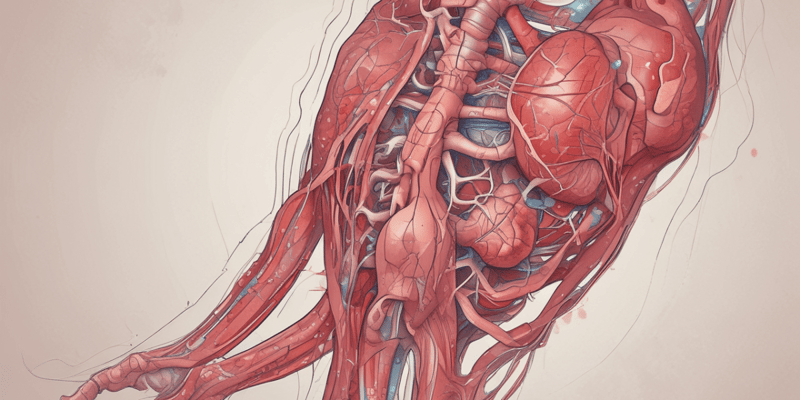Podcast Beta
Questions and Answers
Which symptom is commonly associated with Takayasu's arteritis?
What population is primarily affected by Takayasu's arteritis?
Which of the following is NOT a neurological symptom associated with Takayasu's arteritis?
Takayasu's arteritis primarily involves inflammation of which type of arteries?
Signup and view all the answers
Which clinical feature could suggest a circulatory compromise in a patient with Takayasu's arteritis?
Signup and view all the answers
What is commonly compromised in the context of ischemia related to a vessel?
Signup and view all the answers
What is a common clinical feature of Takayasu arteritis?
Signup and view all the answers
What condition is associated with the compromised lumen of a vessel?
Signup and view all the answers
Which form of vasculitis is classified under large vessel vasculitis?
Signup and view all the answers
What outcome may arise from the compromised lumen of a vessel?
Signup and view all the answers
At what age group is polyarteritis nodosa most commonly diagnosed?
Signup and view all the answers
Which mechanism is primarily associated with Henoch-schonlein purpura?
Signup and view all the answers
Which tissues are primarily affected when the lumen of a vessel is compromised?
Signup and view all the answers
Which of the following is a key diagnostic method for polyarteritis nodosa?
Signup and view all the answers
Which vasculitis is categorized as an ANCA-associated vasculitis?
Signup and view all the answers
What ratio represents the male to female prevalence in Takayasu arteritis?
Signup and view all the answers
The ischemia of tissues occurs primarily due to what vascular condition?
Signup and view all the answers
Which condition is a medium vessel arteritis?
Signup and view all the answers
What symptom is typically associated with Kawasaki's disease?
Signup and view all the answers
Eosinophilic granulomatosis with polyangiitis is also known as what syndrome?
Signup and view all the answers
Which of the following clinical features is NOT associated with eosinophilic granulomatosis with polyangiitis (EGPA)?
Signup and view all the answers
What is the mean age of prevalence for granulomatosis with polyangiitis?
Signup and view all the answers
Which type of ANCA-associated vasculitis is characterized primarily by asthma and pulmonary disease?
Signup and view all the answers
What kind of vasculitis does microscopic polyangiitis represent?
Signup and view all the answers
Which clinical feature is commonly associated with granulomatosis with polyangiitis but not with microscopic polyangiitis?
Signup and view all the answers
Study Notes
Large Vessel Vasculitis
- Characterized by compromised vessel lumen, leading to tissue ischemia.
- Includes Giant Cell Arteritis and Takayasu’s Arteritis.
Medium Vessel Arteritis
- Conditions include Polyarteritis Nodosa and Kawasaki’s Disease.
Small Vessel Vasculitis
- Includes various conditions:
- Granulomatosis with Polyangiitis (Wegener’s granulomatosis)
- Eosinophilic Granulomatosis with Polyangiitis (EGPA) (Churg-Strauss syndrome)
- Microscopic Polyangiitis
- Henoch-Schönlein Purpura
- Essential Cryoglobulinemic Vasculitis
- Cutaneous Leukocytoclastic Vasculitis
Major Pathophysiologic Mechanisms
- Immune complex mediated mechanisms involved.
- Conditions related to immune complexes include:
- Henoch-Schönlein Purpura
- Serum Sickness
- Cryoglobulinemia
- Vasculitis associated with chronic viral disease.
ANCA-Associated Vasculitis
- Includes:
- Granulomatosis with Polyangiitis
- Eosinophilic Granulomatosis with Polyangiitis (EGPA)
- Microscopic Polyangiitis
- Associated with antineutrophil cytoplasmic antibodies (ANCA) that target cytoplasmic granule antigens.
Clinical Features of Vasculitis
- Common symptoms include:
- Constitutional symptoms (fatigue, fever)
- Headaches
- Scalp tenderness
- Cranial artery abnormalities
- Visual symptoms
- Claudication and neurologic problems
- Bruit and pulselessness
Takayasu’s Arteritis
- Granulomatous inflammation of large arteries in young women (ages 10-30).
- Female to male ratio of 4:1.
- Clinical symptoms include:
- Upper extremity claudication
- Hypertension
- Pain in carotid arteries
- Visual abnormalities
- Musculoskeletal symptoms
- Bruit, pulselessness, blood pressure discrepancies
- Erythema nodosum
- Cardiac and pulmonary symptoms.
Polyarteritis Nodosa
- Most prevalent in individuals in their 5th-6th decade of life (age group).
- Male to female ratio is 2:1.
- Symptoms include:
- Muscle pain or weakness
- Weight loss
- Mononeuritis multiplex
- Polyneuropathy
- Azotemia and hypertension
- Testicular pain
- Skin ulcers and infarcts
- Livedo reticularis
- Abdominal pain.
- Diagnosis often involves biopsy and angiography.
Kawasaki’s Disease
- Acute febrile illness associated with systemic vasculitis primarily in infants and young children (mean age 1.5 years).
- Male to female ratio of 1.5:1.
- Principal clinical features:
- Fever
- Rash
- Conjunctivitis
- Changes in lips and oral cavity
- Changes in peripheral extremities
- Cervical lymphadenopathy.
Granulomatosis with Polyangiitis (Wegener’s Granulomatosis)
- Prevalence of 0.003%.
- Affects all age groups (mean age 41).
- Male to female ratio is equal.
- Clinical features include involvement of:
- Upper airway
- Lungs
- Kidneys
- Eyes
- Skin
- Musculoskeletal system
- Gastrointestinal, genitourinary, and cardiac systems.
Eosinophilic Granulomatosis with Polyangiitis (EGPA)
- Also known as Churg-Strauss syndrome.
- Key symptoms include:
- Asthma and pulmonary disease
- Nervous system involvement
- Renal disease
- Skin manifestations
- Gastrointestinal, cardiac, and ocular symptoms.
Microscopic Polyangiitis
- Affects small vessels with minimal or no immune deposits.
- Characterized by necrotizing vasculitis.
Studying That Suits You
Use AI to generate personalized quizzes and flashcards to suit your learning preferences.
Related Documents
Description
Explore the key clinical features of Takayasu's Arteritis, a granulomatous inflammatory disease primarily affecting large arteries in children and young women. Test your knowledge on symptoms such as headache, claudication, and neurological problems. This quiz will help consolidate your understanding of this rare condition.



